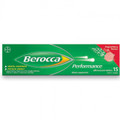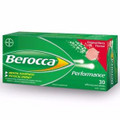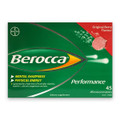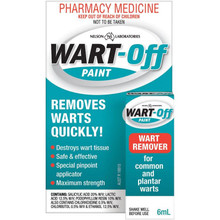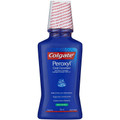 Loading... Please wait...
Loading... Please wait...Product Description
Overview
For the removal of common and planter warts
Warnings
Do not use if you are a diabetic, have impaired circulation, nerve damage or have had a previous operation around the wart area.
Use Wart-Off only on common and plantar warts.
Wart-Off should not be applied to broken skin, moles, birthmarks or unusual skin growths.
Wart-OFF may cause infection. If infection occurs discontinue use and seek medical advice.
Do not use on infants or very young children unless on medical advice.
Do not treat more than one wart in close proximity to another, or over large areas, at one time.
Do not apply to your face or ano-genital areas.
Wart-Off contains acid to destroy tissue. If burning or stinging occurs wash thoroughly with running water and apply an antiseptic cream.
Use Wart-Off only on common and plantar warts.
Wart-Off should not be applied to broken skin, moles, birthmarks or unusual skin growths.
Wart-OFF may cause infection. If infection occurs discontinue use and seek medical advice.
Do not use on infants or very young children unless on medical advice.
Do not treat more than one wart in close proximity to another, or over large areas, at one time.
Do not apply to your face or ano-genital areas.
Wart-Off contains acid to destroy tissue. If burning or stinging occurs wash thoroughly with running water and apply an antiseptic cream.
Ingredients
Salicylic acid 20% w/v, Latic acid 12.5% w/v, Podophyllum resin 10% w/v, Chlorhexidine 0.5% w/v, Chlorbutol 0.5% w/v, ethanol 12.5% w/v
Directions
1. Mask the area around the wart by: a) Smearing petroleum jelly around it, Not on it; b) Paint around it with Nail Varnish; c) Use a felt corn ring; d) Cut plaster around the wart.
2. Apply a very small amount of Wart-Off on the top of the wart only, using the applicator. Avoid contact with surrounding skin.
3. Allow the Wart-Off paint to dry, then cover the wart with plaster (preferably waterproof) so it does not breath. Do not leave wart uncovered.
4. Wash hands thoroughly after applying Wart-Off. Ir a waterproof plaster is used to cover the wart, washing hands will not affect the treatment. If you use a non waterproof bandaid, do not put wart area in water as this can cause acid to run onto skin and cause burning.
5. Repeat once or twice daily until the wart has completely cleared. Change the plaster every couple of days or as desired. Should the condition persist consult a physician.
2. Apply a very small amount of Wart-Off on the top of the wart only, using the applicator. Avoid contact with surrounding skin.
3. Allow the Wart-Off paint to dry, then cover the wart with plaster (preferably waterproof) so it does not breath. Do not leave wart uncovered.
4. Wash hands thoroughly after applying Wart-Off. Ir a waterproof plaster is used to cover the wart, washing hands will not affect the treatment. If you use a non waterproof bandaid, do not put wart area in water as this can cause acid to run onto skin and cause burning.
5. Repeat once or twice daily until the wart has completely cleared. Change the plaster every couple of days or as desired. Should the condition persist consult a physician.


